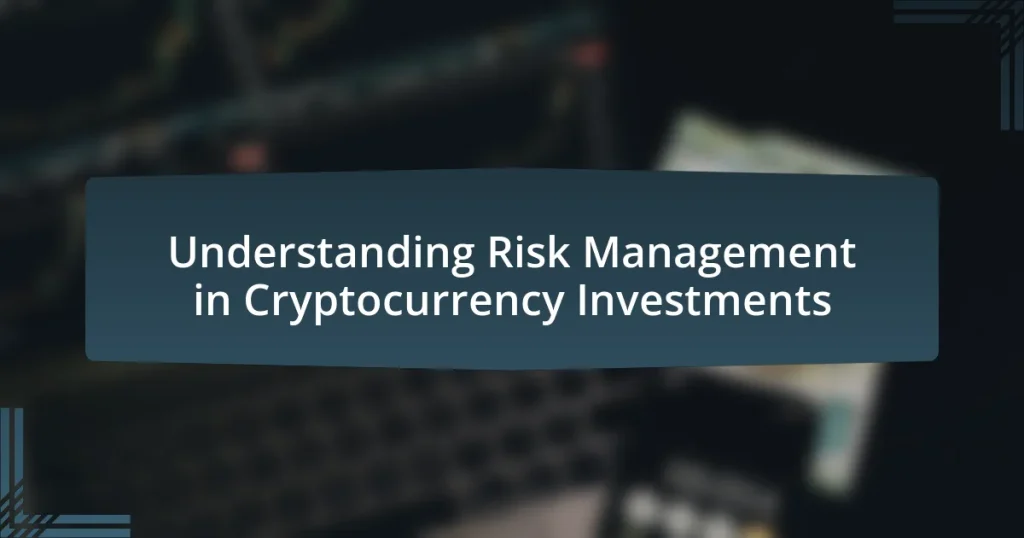Risk management in cryptocurrency investments is a systematic approach aimed at identifying, assessing, and mitigating potential financial losses in the volatile digital currency market. The article outlines the importance of effective risk management strategies, such as diversification, stop-loss orders, and continuous monitoring, to protect investors from significant losses. It also discusses unique risks associated with cryptocurrencies, including high volatility, regulatory uncertainty, and cybersecurity threats, while emphasizing the need for thorough research and the use of various analytical tools for risk assessment. Key components of a successful risk management plan are highlighted, along with practical tips for investors to enhance their strategies and maintain portfolio stability.

What is Risk Management in Cryptocurrency Investments?
Risk management in cryptocurrency investments refers to the systematic process of identifying, assessing, and mitigating potential financial losses associated with investing in digital currencies. This involves strategies such as diversification, setting stop-loss orders, and conducting thorough market analysis to minimize exposure to volatility and market risks. According to a report by the CFA Institute, effective risk management can significantly enhance investment performance by reducing the likelihood of substantial losses, which is particularly crucial in the highly volatile cryptocurrency market.
Why is risk management crucial in cryptocurrency investments?
Risk management is crucial in cryptocurrency investments because it helps investors mitigate potential losses in a highly volatile market. The cryptocurrency market is characterized by significant price fluctuations, with some assets experiencing swings of over 20% in a single day. Effective risk management strategies, such as diversification and setting stop-loss orders, can protect investors from severe financial downturns. Historical data shows that during market corrections, such as the 2018 bear market where Bitcoin’s price dropped by approximately 84%, those who employed risk management techniques were better positioned to preserve their capital.
What unique risks are associated with cryptocurrency investments?
Cryptocurrency investments carry unique risks including high volatility, regulatory uncertainty, cybersecurity threats, and lack of consumer protections. High volatility is evidenced by Bitcoin’s price fluctuations, which can exceed 10% in a single day, leading to significant financial losses. Regulatory uncertainty arises from varying global regulations, as seen in countries like China, which has imposed strict bans on cryptocurrency trading. Cybersecurity threats are prevalent, with exchanges being targeted by hackers; for instance, the Mt. Gox hack in 2014 resulted in the loss of 850,000 Bitcoins. Lastly, the lack of consumer protections means investors may have limited recourse in cases of fraud or theft, unlike traditional financial systems.
How does volatility impact risk management strategies?
Volatility significantly impacts risk management strategies by necessitating more dynamic and responsive approaches to mitigate potential losses. In highly volatile markets, such as cryptocurrency, the rapid price fluctuations can lead to substantial financial risks, prompting investors to adopt strategies like stop-loss orders, diversification, and position sizing to protect their capital. For instance, a study by Baur and Dimpfl (2018) found that increased volatility in cryptocurrency markets correlates with heightened risk perceptions, leading investors to adjust their risk management tactics accordingly. This adaptability is crucial for maintaining portfolio stability in the face of unpredictable market movements.
What are the key components of effective risk management in cryptocurrency?
The key components of effective risk management in cryptocurrency include risk identification, risk assessment, risk mitigation strategies, and continuous monitoring. Risk identification involves recognizing potential risks such as market volatility, regulatory changes, and cybersecurity threats. Risk assessment evaluates the likelihood and impact of these risks, allowing investors to prioritize them. Risk mitigation strategies may include diversifying investments, using stop-loss orders, and employing secure storage solutions for digital assets. Continuous monitoring ensures that investors stay informed about market conditions and adjust their strategies accordingly. These components collectively help investors manage the inherent risks associated with cryptocurrency investments.
How do diversification and asset allocation play a role?
Diversification and asset allocation are crucial strategies in managing risk within cryptocurrency investments. Diversification involves spreading investments across various cryptocurrencies to reduce exposure to any single asset’s volatility, thereby minimizing potential losses. Asset allocation refers to the strategic distribution of an investor’s portfolio among different asset classes, such as cryptocurrencies, stocks, and bonds, to balance risk and return based on individual risk tolerance and investment goals. Research indicates that a well-diversified portfolio can significantly lower risk; for instance, a study by Markowitz in 1952 demonstrated that diversification can lead to a more efficient frontier in investment portfolios, optimizing returns for a given level of risk.
What tools and techniques are used for risk assessment?
Risk assessment in cryptocurrency investments utilizes various tools and techniques, including quantitative analysis, qualitative analysis, risk matrices, and scenario analysis. Quantitative analysis involves statistical methods to evaluate historical price volatility and market trends, providing data-driven insights into potential risks. Qualitative analysis assesses non-numerical factors such as regulatory changes, market sentiment, and technological developments that could impact investments. Risk matrices visually represent the likelihood and impact of identified risks, aiding in prioritization. Scenario analysis explores potential future events and their effects on investments, allowing investors to prepare for various outcomes. These methods collectively enhance the understanding and management of risks associated with cryptocurrency investments.
How can investors identify and evaluate risks in cryptocurrency?
Investors can identify and evaluate risks in cryptocurrency by conducting thorough research, analyzing market trends, and utilizing risk assessment tools. Research involves examining the underlying technology, regulatory environment, and historical price movements of specific cryptocurrencies. For instance, the volatility of Bitcoin, which has experienced price swings exceeding 20% in a single day, highlights the inherent market risk.
Additionally, investors should assess the liquidity of the cryptocurrency, as lower liquidity can lead to larger price fluctuations. Tools such as Value at Risk (VaR) can quantify potential losses in investment portfolios, providing a statistical measure of risk. By combining these methods, investors can form a comprehensive understanding of the risks associated with their cryptocurrency investments.
What methods are available for analyzing market trends?
Methods available for analyzing market trends include technical analysis, fundamental analysis, sentiment analysis, and quantitative analysis. Technical analysis involves examining historical price data and chart patterns to forecast future price movements. Fundamental analysis assesses the underlying factors affecting an asset’s value, such as economic indicators and market news. Sentiment analysis gauges market sentiment through social media, news articles, and investor behavior to predict trends. Quantitative analysis employs statistical and mathematical models to analyze market data and identify patterns. Each method provides unique insights, enabling investors to make informed decisions in the cryptocurrency market.
How do regulatory changes affect risk evaluation?
Regulatory changes significantly impact risk evaluation by altering the legal landscape within which cryptocurrency investments operate. These changes can introduce new compliance requirements, affecting the operational risks associated with investments. For instance, the implementation of stricter anti-money laundering (AML) regulations can increase the costs of compliance for cryptocurrency exchanges, thereby influencing their risk profiles. Additionally, regulatory clarity can enhance investor confidence, potentially reducing perceived risks and leading to increased market participation. Historical examples, such as the introduction of the European Union’s Fifth Anti-Money Laundering Directive in 2018, demonstrate how regulatory shifts can reshape market dynamics and risk assessments in the cryptocurrency sector.
What strategies can be employed to mitigate risks in cryptocurrency investments?
To mitigate risks in cryptocurrency investments, investors can employ strategies such as diversification, thorough research, and the use of stop-loss orders. Diversification involves spreading investments across various cryptocurrencies to reduce exposure to any single asset’s volatility. Researching the fundamentals of each cryptocurrency, including its technology, use case, and market trends, helps investors make informed decisions. Additionally, implementing stop-loss orders allows investors to automatically sell assets when they reach a predetermined price, limiting potential losses. These strategies are supported by the fact that diversified portfolios tend to have lower risk and that informed decision-making can lead to better investment outcomes.
How can stop-loss orders help manage risk?
Stop-loss orders help manage risk by automatically selling an asset when its price falls to a predetermined level, thereby limiting potential losses. This mechanism allows investors to set a specific exit point, which can prevent emotional decision-making during market volatility. For instance, if an investor buys a cryptocurrency at $1,000 and sets a stop-loss order at $900, the asset will be sold if the price drops to that level, capping the loss at 10%. This strategy is widely used in trading to protect capital and maintain a disciplined approach to investment, especially in the highly volatile cryptocurrency market.
What role does continuous monitoring play in risk management?
Continuous monitoring plays a critical role in risk management by enabling organizations to identify and respond to potential risks in real-time. This proactive approach allows for the timely detection of anomalies, market fluctuations, and security threats, which is essential in the volatile landscape of cryptocurrency investments. For instance, a study by the International Journal of Information Management highlights that continuous monitoring can reduce the response time to incidents by up to 50%, thereby minimizing potential losses. By integrating continuous monitoring into risk management strategies, organizations can enhance their ability to safeguard assets and maintain compliance with regulatory requirements.
How does psychological bias affect risk management in cryptocurrency?
Psychological bias significantly impacts risk management in cryptocurrency by influencing investors’ decision-making processes. Cognitive biases, such as overconfidence and loss aversion, can lead to poor risk assessment and management strategies. For instance, overconfidence may cause investors to underestimate potential losses, resulting in inadequate risk mitigation measures. Additionally, loss aversion can lead to holding onto losing investments longer than advisable, as investors fear realizing losses. Research indicates that these biases can distort market behavior, contributing to volatility and irrational trading patterns, which ultimately complicate effective risk management in the cryptocurrency market.
What common biases should investors be aware of?
Investors should be aware of several common biases that can impact their decision-making. These include confirmation bias, where investors favor information that confirms their existing beliefs; loss aversion, which leads to a greater sensitivity to losses than to gains; and overconfidence bias, where investors overestimate their knowledge or predictive abilities. Research indicates that these biases can significantly affect investment outcomes, as evidenced by studies showing that overconfident investors tend to trade more frequently and underperform the market. Understanding these biases is crucial for effective risk management in cryptocurrency investments.
How can investors overcome emotional decision-making?
Investors can overcome emotional decision-making by implementing a structured investment strategy that includes setting clear goals, utilizing risk management techniques, and maintaining a disciplined approach. Establishing specific investment objectives helps investors focus on long-term outcomes rather than short-term market fluctuations. Techniques such as diversification and setting stop-loss orders can mitigate risks and reduce the emotional impact of market volatility. Research indicates that disciplined investors who adhere to a predefined strategy are less likely to make impulsive decisions during market stress, as evidenced by a study published in the Journal of Behavioral Finance, which found that emotional decision-making often leads to suboptimal investment performance.
What are the best practices for implementing risk management in cryptocurrency investments?
The best practices for implementing risk management in cryptocurrency investments include diversifying your portfolio, setting clear investment goals, using stop-loss orders, conducting thorough research, and regularly reviewing your investments. Diversification reduces the impact of a poor-performing asset by spreading risk across various cryptocurrencies. Setting clear investment goals helps investors maintain focus and avoid emotional decision-making. Stop-loss orders automatically sell assets at predetermined prices, limiting potential losses. Conducting thorough research ensures informed decisions based on market trends and project fundamentals. Regularly reviewing investments allows for adjustments based on performance and market conditions, enhancing overall risk management.
How can investors create a personalized risk management plan?
Investors can create a personalized risk management plan by assessing their individual risk tolerance, defining investment goals, and implementing strategies tailored to their financial situation. First, investors should evaluate their risk tolerance, which involves understanding how much volatility they can withstand without panic selling. This can be quantified through questionnaires or self-assessment tools that gauge emotional responses to market fluctuations.
Next, investors must clearly define their investment goals, such as time horizon, expected returns, and specific financial objectives. This clarity helps in selecting appropriate assets and risk levels. For instance, a long-term investor may opt for higher-risk assets, while a short-term investor might prioritize stability.
Finally, implementing strategies such as diversification, setting stop-loss orders, and regularly reviewing the portfolio ensures that the risk management plan remains aligned with changing market conditions and personal circumstances. Research indicates that diversified portfolios can reduce risk without sacrificing returns, as shown in studies by Markowitz (1952) on Modern Portfolio Theory.
What resources are available for ongoing education in risk management?
Resources available for ongoing education in risk management include professional certifications, online courses, webinars, and industry publications. Certifications such as the Certified Risk Manager (CRM) and the Project Management Institute’s Risk Management Professional (PMI-RMP) provide structured learning and recognition in the field. Online platforms like Coursera and edX offer courses specifically focused on risk management principles and practices. Webinars hosted by organizations like the Risk Management Society (RIMS) provide current insights and trends. Additionally, industry publications such as the Journal of Risk Management and the Risk Management Magazine offer valuable articles and research findings that contribute to continuous learning in risk management.
What practical tips can enhance risk management in cryptocurrency investments?
To enhance risk management in cryptocurrency investments, investors should diversify their portfolios across multiple cryptocurrencies. Diversification reduces the impact of a poor-performing asset on the overall portfolio, as evidenced by studies showing that a diversified portfolio can lower volatility and risk. Additionally, setting stop-loss orders can help limit potential losses by automatically selling assets when they reach a predetermined price, which is a common strategy used by traders to protect their investments. Regularly reviewing and adjusting investment strategies based on market conditions is also crucial, as the cryptocurrency market is highly volatile and can change rapidly. Implementing these practical tips can significantly improve risk management in cryptocurrency investments.










